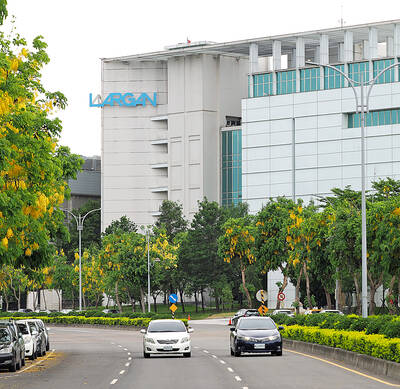The average monthly regular wage in August rose by 3.08 percent from a year earlier to NT$46,751 (US$1,453), while the average total monthly wage — including overtime pay, performance-based commissions and bonuses — spiked by 6.02 percent to NT$59,420, the Directorate-General of Budget, Accounting and Statistics (DGBAS) said yesterday.
The statistics agency attributed the growth mainly to firms’ willingness to offer better compensation to attract and retain employees.
Its observation received support from the median wage — a more accurate reflection of typical earnings, as it is not skewed by extreme high or low wages — which stood at NT$37,502 in August, an annual increase of 3.77 percent, DGBAS data showed.

Photo: CNA
Employees at financial and insurance companies on average had the highest total monthly wages at NT$119,709, trailed by NT$107,620 at electronics vendors and NT$104,957 at electricity suppliers, the agency said, citing wage statistics in the first eight months.
By contrast, non-school education facilities had the lowest total monthly wages of NT$34,766, followed by hotels and restaurants at NT$39,140, and alternative services providers at NT$40,489, it said, but added that the figures were a noticeable improvement from the pre-COVID-19 pandemic era.
Male workers had a median monthly wage of NT$38,830, which was about 10 percent higher than their female counterparts at NT$35,136, suggesting a pickup of 3.25 percent and 2.95 percent respectively, the DGBAS said.
People aged between 50 and 64 have higher median regular pay at NT$42,008 per month, much better than people under 30 years old at NT$31,033, the agency said, adding that experience and seniority helped.
However, people aged older than 65, most of whom re-entered the workforce after retirement, had a median pay of NT$37,286, it said.
The average monthly wage was highest among people with graduate diplomas at NT$62,792, followed at a distant second by people with junior college or university degrees at NT$39,129, lending support to the belief that investment in education pays off, the DGBAS said.
Meanwhile, the industrial and service sectors added 2,000 personnel, so the overall number of workers grew 0.03 percent to 8.47 million, the agency said.
Overtime increased by 0.9 hours to 8.7 hours, as the high season for technology products approaches.
In the first eight months, headline regular monthly wages gained 2.66 percent to NT$46,331, while overall compensation bounced by 4.27 percent to NT$63,261, it said.
The data represented upticks of 0.35 percent and 1.92 percent respectively after adjustments for inflation, it added.

Taiwan’s foreign exchange reserves hit a record high at the end of last month, surpassing the US$600 billion mark for the first time, the central bank said yesterday. Last month, the country’s foreign exchange reserves rose US$5.51 billion from a month earlier to reach US$602.94 billion due to an increase in returns from the central bank’s portfolio management, the movement of other foreign currencies in the portfolio against the US dollar and the bank’s efforts to smooth the volatility of the New Taiwan dollar. Department of Foreign Exchange Director-General Eugene Tsai (蔡炯民)said a rate cut cycle launched by the US Federal Reserve

Handset camera lens maker Largan Precision Co (大立光) on Sunday reported a 6.71 percent year-on-year decline in revenue for the third quarter, despite revenue last month hitting the highest level in 11 months. Third-quarter revenue was NT$17.68 billion (US$581.2 million), compared with NT$18.95 billion a year earlier, the company said in a statement. The figure was in line with Yuanta Securities Investment Consulting Co’s (元大投顧) forecast of NT$17.9 billion, but missed the market consensus estimate of NT$18.97 billion. The third-quarter revenue was a 51.44 percent increase from NT$11.67 billion in the second quarter, as the quarter is usually the peak

Nvidia Corp’s major server production partner Hon Hai Precision Industry Co (鴻海精密) reported 10.99 percent year-on-year growth in quarterly sales, signaling healthy demand for artificial intelligence (AI) infrastructure. Revenue totaled NT$2.06 trillion (US$67.72 billion) in the last quarter, in line with analysts’ projections, a company statement said. On a quarterly basis, revenue was up 14.47 percent. Hon Hai’s businesses cover four primary product segments: cloud and networking, smart consumer electronics, computing, and components and other products. Last quarter, “cloud and networking products delivered strong growth, components and other products demonstrated significant growth, while smart consumer electronics and computing products slightly declined,” compared with the

The US government on Wednesday sanctioned more than two dozen companies in China, Turkey and the United Arab Emirates, including offshoots of a US chip firm, accusing the businesses of providing illicit support to Iran’s military or proxies. The US Department of Commerce included two subsidiaries of US-based chip distributor Arrow Electronics Inc (艾睿電子) on its so-called entity list published on the federal register for facilitating purchases by Iran’s proxies of US tech. Arrow spokesman John Hourigan said that the subsidiaries have been operating in full compliance with US export control regulations and his company is discussing with the US Bureau of